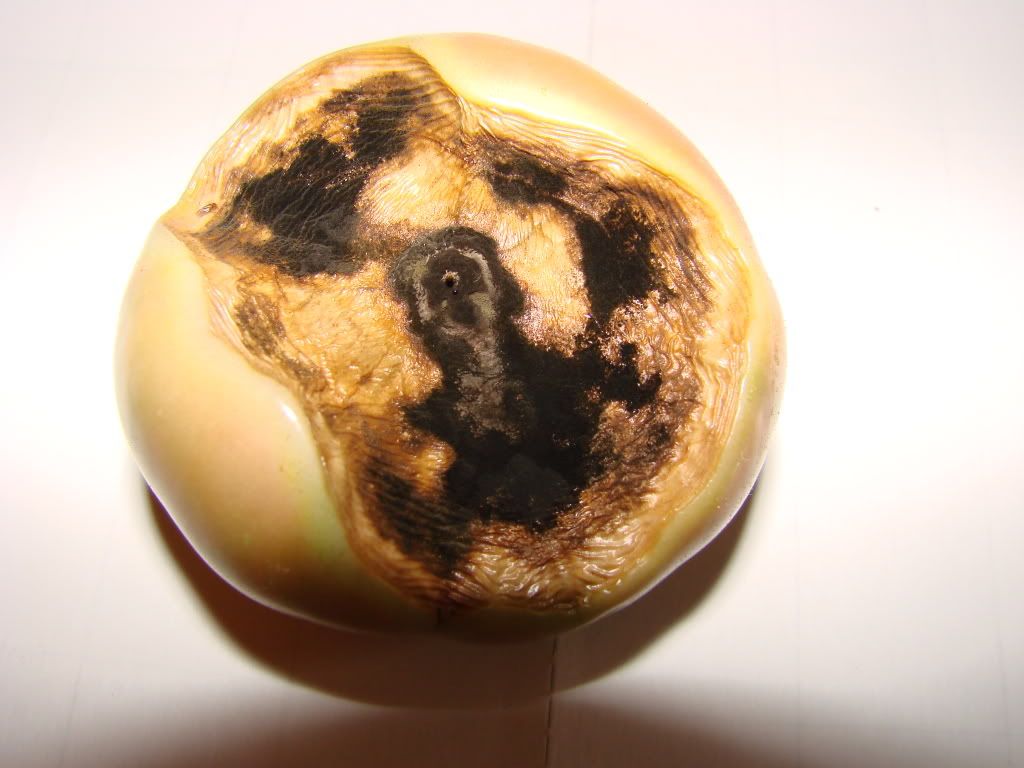

|
Information and discussion regarding garden diseases, insects and other unwelcome critters.
|
 |
|
|
Thread Tools | Display Modes |
|
|
#1 |
|
Tomatovillian™
Join Date: Jul 2011
Location: in the gutter, with my mouth
Posts: 123
|
This was on my Big Cheef that I have in a pot on my driveway.
Not sure what is and can't seem to find out what it is. Thanks Dono 
|
|
|

|
|
|
#2 |
|
Tomatovillian™
Join Date: Feb 2012
Location: Texas Coastal Bend
Posts: 3,205
|
Looks like Blossom End Rot to me.
__________________
In the spring at the end of the day you should smell like dirt ~Margaret Atwood~     |
|
|

|
|
|
#3 |
|
Tomatovillian™
Join Date: Dec 2011
Location: oak grove mo
Posts: 406
|
agreed ber
|
|
|

|
|
|
#4 |
|
Tomatovillian™
Join Date: Jun 2010
Location: England
Posts: 512
|
Is it the blossom end or the stem end that is affected? That looks like the stem end of the tomato to me.
If it is the stem end then it might be something else like early blight or gray mold or some other fungal problem. |
|
|

|
|
|
#5 |
|
Tomatovillian™
Join Date: Jun 2010
Location: Cheektowaga, NY
Posts: 2,466
|
Looks like Anthracnose. Sunken spots and concentric rings with black microsclerotia.
|
|
|

|
|
|
#6 |
|
Tomatovillian™
Join Date: Oct 2011
Location: Homestead,Everglades City Fl.
Posts: 2,501
|
http://search.aol.com/aol/image?q=to...yword_rollover Look at pic #11. http://search.aol.com/aol/image?q=to...yword_rollover
__________________
KURT Last edited by kurt; September 30, 2012 at 09:08 PM. Reason: Bad news is seed transmission also |
|
|

|
|
|
#7 |
|
Tomatovillian™
Join Date: Aug 2011
Location: Plantation, Florida zone 10
Posts: 9,283
|
It is Blossom end rot. Anthracnose had the wateryness and the fungal appearance too. This is not anthracnose. BER is super common, and although it is a deficiency of calcium absorption, most here think you don't need to do anything, the plant will simply outgrow it.
Some here think you need to give it a calcium "snack" Carolyn is of the first persuasion, and Raybo is of the second. Many threads here on it. |
|
|

|
|
|
#8 |
|
Tomatovillian™
Join Date: Jul 2011
Location: in the gutter, with my mouth
Posts: 123
|
I'm thinking BER now. Thanks. I went out and found another one. I wasn't expecting it this late in the season.
Thanks Dono |
|
|

|
|
|
#9 |
|
Tomatovillian™
Join Date: Oct 2011
Location: Homestead,Everglades City Fl.
Posts: 2,501
|
Was it on the stem or blossom end?
__________________
KURT |
|
|

|
|
|
#10 |
|
Tomatovillian™
Join Date: Jul 2011
Location: in the gutter, with my mouth
Posts: 123
|
|
|
|

|
|
|
#11 |
|
Tomatovillian™
Join Date: Jul 2011
Location: in the gutter, with my mouth
Posts: 123
|
sorry kurt i missed your post with the link. Now you got me wondering.
Still thinking more towards BER but am not sure Thanks |
|
|

|
|
|
#12 |
|
Tomatovillian™
Join Date: Jun 2010
Location: Cheektowaga, NY
Posts: 2,466
|
It is possible to have BER and an opportunistic fungal pathogen as a secondary problem on the senescing tissue. Do both the tomatoes you found have the same appearance on the blossom end? Any other spots on other areas of the fruit?
If it is Anthracnose there, then the black microsclerotia which are the fruiting bodies that make the spores would eventually create pinkish colored spore masses. You could bag the tomatoes in a clear plastic bag and see if any spore masses form. |
|
|

|
|
|
#13 |
|
Tomatovillian™
Join Date: Jul 2011
Location: in the gutter, with my mouth
Posts: 123
|
Thanks Ray, I'm not an expert with disease...yet. But the second one I found was more BER like. I belive the pictured one just was missed and went to a more advanced stage.
I could be wrong, or should I say I hope I'm right and it's just BER. I will keep and eye on this. Not sure if it matters but I have bad whiteflys as well I'm batteling on this plant. |
|
|

|
|
|
#14 | |
|
Moderator Emeritus
Join Date: Jan 2006
Location: Upstate NY, zone 4b/5a
Posts: 21,169
|
Quote:
And yes, the initial lesion of BER can be and often is secondarily colonized by both normal fungi and bacteria in the air but most common are fungi and the most common fungi give a black growth and the most common genus is Aspergillus. And the most common species of Aspergillus is niger, so put it together and you've got A. niger. ( niger means black) http://www.google.com/search?num=10&....1.qSoubLu7ZCk Above is a link to Google IMAGES showing many pictures of BER and most with the black fungi overgrowing the initial beige leathery spot of BER. For those who haven't looked at Google images before, just put your mouse pointer over a picture and up comes a window that confirms what you're looking at and also tells you where the picture is from. Hope that helps.
__________________
Carolyn |
|
|
|

|
|
|
#15 |
|
Tomatovillian™
Join Date: Jul 2011
Location: in the gutter, with my mouth
Posts: 123
|
Thanks Carolyn. That is what I thought.
|
|
|

|
 |
|
|
